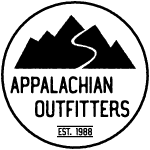
Winter in Ohio can mean a lot of things. It can mean sunny and 40 degrees on Monday and snow and a -5 windchill on Wednesday. For maximum comfort when hiking, it’s important to know how to layer your clothing. Everything that applies to layering for the top half of your body will also apply to the bottom half. Your top layering system will only do you so much good if on the bottom you're simply wearing leggings you bought from Target. The typical layering system most commonly has three components. They are as follows:
- Baselayer: For moisture wicking
- Middle Layer: Insulating layer
- Outer Layer: Wind/Rain shield
Layer 1: Baselayers
The first layer you wear will be your baselayer. These are used for wicking moisture, therefore the most important aspect of your baselayer is the fabric it is made out of, closely followed by the weight (thickness) of the material. Baselayer fabric types include merino wool, synthetics, silks and more. The thickness you choose is dependent on what you plan to do and what the weather will be like. Warm weather hiking can more often than not be done in just a thin (light weight) baselayer. Cold weather and winter hiking, however, is optimally done in a thicker (mid/heavy weight) baselayer for added warmth. When sizing your first layer, you will want them to fit close to the body. A loose baselayer will not be able to properly perform if it is not close to the skin so it can absorb and wick away sweat. Some examples of baselayer options include the Smartwool 250 Baselayer , Rab Forge LS Tee and the Terramar Cloud Nine Turtle Neck . Bottom baselayer options include Rab Forge Leggings, Capilene Thermal Weight Bottoms and the Smartwool 250 Leggings.
Layer 2: Insulating Layer
After your baselayer comes the insulating layer. This is your first layer that will actually help retain the heat your body is generating. Keep in mind that thicker generally means warmer, but not always. Quality of insulation will have a profound effect. The Patagonia Nano Puff might be thinner, but compared to a $20 dollar puffy from Walmart, will stand up much better when put to the test. A midlayer will be something like a fleece, down or synthetic insulated jacket. Almost every outdoor brand will have some type of fleece midlayer that will work for hiking. Fleece layers are more commonly used for fall hikes where temperatures have not quite dropped too low and where you won’t be fighting strong winds. Fleece does a good job of keeping you warm, but tends to hold moisture and become wet. For winter a down or synthetic jacket will be more appropriate due to their added ability to block some wind and to resist moisture from flurries. Examples of great mid layers would be the Smartloft 60 Jacket , a thick fleece from virtually any brand or the Patagonia Nano Puff Jacket .
Layer 3: Wind/Rain Layer
The third layer in your system will be for wind and water resistance. This layer may often be referred to as your hard shell. It is a layer that will keep the wind from cutting through you and keep light flurries and rain from soaking through to your base layer. However, when it comes to rain and wind, there is more to think about than just keeping the rain and snow out. Some rain jackets are meant to keep you dry and breath well; this means you’ll be dry, but they won't help protect you from the wind. Other jackets are highly wind resistant, but do not breathe at all and will retain an incredible amount of heat. An outer layer like that would best be used for low level activity or if you don’t plan to be out long. The amount of heat you generate from hiking a long distance, even if it’s cold out, may surprise you. Before choosing this last layer, identify which conditions are more pressing and which you will need more protection from. If it’s going to be rainy and wet out, don’t forget to add that extra rain layer for your legs as well. Just as every brand has their own rain jacket, most brands also make waterproof bottoms as well. Great all around outer layers include the Patagonia Torrentshell 3L, Arc'teryx Zeta SL and the Precip Eco Pants.
Most importantly, make sure your layers are working together. Layering a fleece with a heavy rain jacket that does not breathe is going to cause a lot of moisture to build up and ultimately undermine the purpose of the fleece. Consider the level of activity you will be doing and the weather for that time. Socks and gloves are also important to consider when layering and often follow a similar pattern. Layering may seem like a lot of nonsense, but it makes a difference. When you layer properly with a baselayer, insulating layer and then hard shell layer, instead of just that cotton t-shirt, old sweatshirt and thick crunchy rain jacket from 1998, you will notice the difference.


